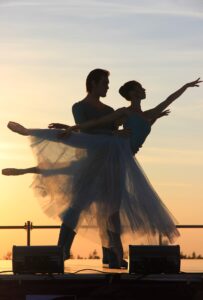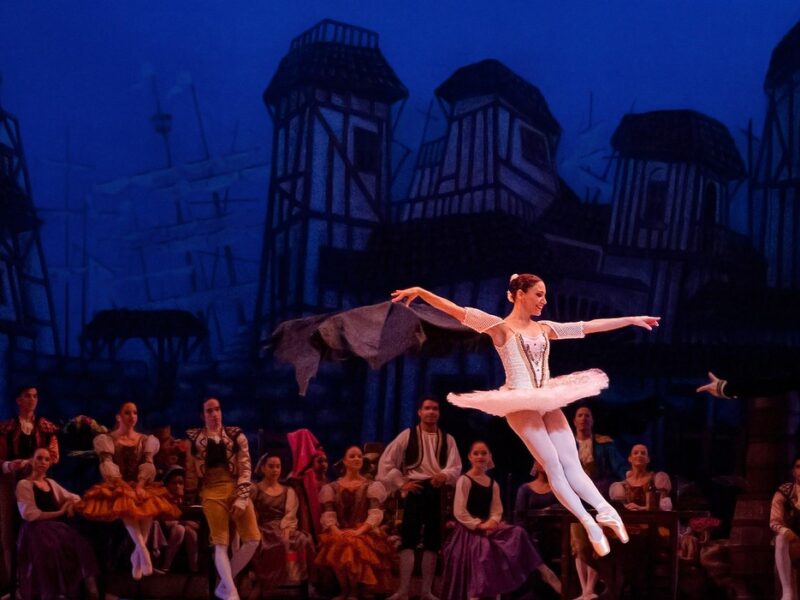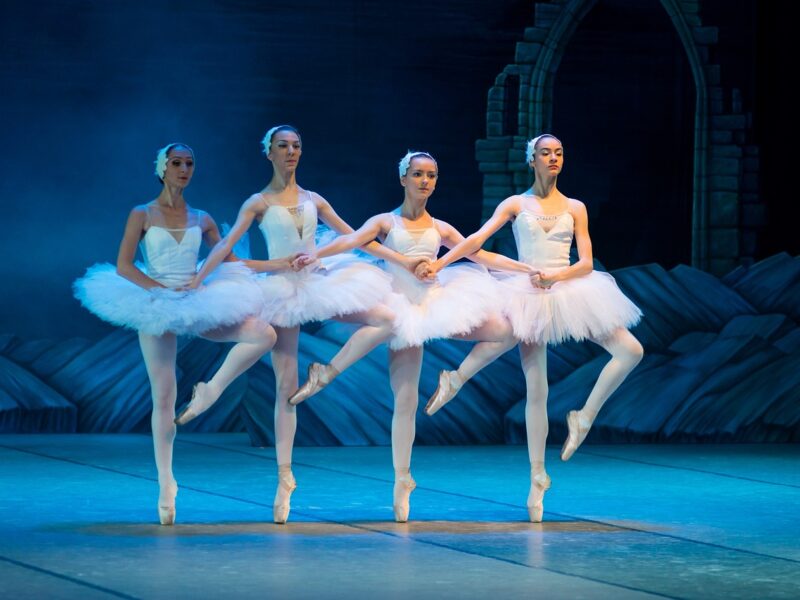Arabesque… one of the most common positions in ballet yet one of the hardest to perfect. Every bunhead is striving to get their legs higher whilst keeping their back up, but what if I told you that there’s a way you too can achieve a higher arabesque and the lines that all dancers dream of?
For a little while, I’ve been the keeping the best secrets to a higher arabesque to myself, however I’ve decided that now is the time to let my fellow ballerinas in on the greatest tips and hacks that you can use to cross-train your way to stunning rear leg extensions.
It’s a very common misconception that the height of our arabesque is dictated by the strength of our ‘back muscles’, and although the muscles of our posterior spine are used in arabesque, it’s actually the core that does most of the work to provide spinal stability when we lift our leg! Now that you’ve heard secret number 1, let me explain how it actually works…
When we perform spinal extension (or bend backwards) our spine requires support. This support comes from the deep core muscles, or more specifically the transversus abdominis, the internal and external obliques and the pelvic floor muscles.
When our spine extends, these muscles contract eccentrically to support it. This means that as we bend backwards, the muscles of our trunk contract whilst lengthening at the same time, stabilising our spine whilst also allowing it to extend! Strengthening our deep core muscles can help us to achieve beautiful spinal extension in our arabesque by stabilising and supporting our back as it bends.
As I was saying, even though the muscles of our trunk are super important for spinal extensions, we do also need strength in the muscles of our back to help us keep our chest lifted during arabesques (and that is secret number 2!). These muscles include the erector spinae muscles, as well as the multifidus muscles which are located deep in the spine and support the vertebrae. Performing spinal extensions against the resistance of gravity can help us to strengthen these muscles for a higher arabesque.
The third and final secret on our quest for a higher arabesque is the role of the hip extensors. The enviable height and lifted chests that we all strive for in our rear leg extensions comes from a careful balance of strength in our spinal extension and hip extension. We’ve already discussed the former, but what are these hip extensors, and how can they help us to achieve a higher arabesque?
While we use the muscles of our trunk and spine to stabilise our back and keep our chests lifted, the height of our leg in arabesque is majorly determined by the strength of our hip extensors. Hip extension is the opposite of hip flexion, and involves moving our leg behind us which lengthens the hip flexor (picture a dégagé derrière). The hip extensors are made up of the glutes, hamstrings and adductor magnus, and strengthening these muscles is an incredibly effective way of improving the height of our arabesques!
Now that we know the science behind amazing arabesques, it’s time to start putting it into practice! Keep reading for all the best exercises to help you achieve a higher arabesque…

Exercise #1 – half shoulder stand with hip flexion in pike
For our first exercise we are going to target the core, and the half shoulder stand is a great one for activating and strengthening the transversus abdominis as well as the other all-important muscles of our trunk!
A strong core (in particular a strong transversus abdominis) is essential for improving technique and gaining height in our arabesque. This is because one of the muscle’s main functions is to stabilise and support our spine so that we can move the rest of our body without wobbling or falling off balance!
Strengthening our trunk muscles will improve their ability to contract eccentrically, providing support to our spine as it extends during arabesque. This will help us to keep our chests lifted in arabesque so that we may achieve those beautiful lines we all want so badly!
Step 1 – Lie on your back with your legs in a pike position in the air. Your hips should be bent at 90⁰ and your arms should be relaxed by your side
Step 2 – Keeping your legs at a 90⁰ angle, contract your core muscles and lift your pelvis and midback off the floor. Your legs should now be over your head and parallel to the floor
Step 3 – Maintaining the same position, extend your legs upwards towards the ceiling into a shoulder stand position. Keep your arms on the floor by your side.
Step 4 – Bring your legs back into the 90⁰ position before slowly lowering
Top Tip! Other exercises which are great for targeting the transversus abdominis are planks and hollow body holds.
Exercise #2 – cobra stretch
As we now know, during spinal extension our core muscles contract eccentrically (or lengthen during the contraction). This lengthening allows our spine to bend backwards in arabesque to help us keep our chests lifted, however if our abdominals are too tight this movement may be restricted.
Stretching the muscles of our trunk (alongside strengthening them) is a brilliant way of maximising our spinal extension for stunning arabesques!
Step 1 – Lie face down on the floor with your arms bent by your side and your palms pressed down on the floor beside your shoulders
Step 2 – Use your hands to slowly push your torso up into a cobra stretch. Try to keep your pelvis on the floor for a deeper stretch
Step 3 – Hold and slowly lower back to the starting position
Exercise #3 – back-ups in 5th position
In order to keep our chests lifted to achieve gorgeous lines in our arabesques we need so strengthen the muscles of back, in particular the deep multifidus muscles and the erector spinae muscles which support our spine as it bends backwards.
Lifting our backs up of the floor against the natural resistance of gravity is a great way of doing this, and keeping the arms in 5th position increases the challenge!
Step 1 – Lie on the floor face down with your arms extended above your head in 5th position. Your leg should be apart and slightly turned out
Step 2 – Ensuring the movement is slow and controlled, contract your glutes to lift your torso of the floor. Keep your head and neck in line with your spine to avoid strain
Step 3 – Hold for a couple of seconds before you lower and repeat
Too hard? Holding the arms in 5th position may be difficult for newbies to this exercise. If you’re struggling, try bending your arms and placing your hands behind your head as if you are going to do an abdominal crunch.
Exercise #4 – weighted glute bridge
One of the main secrets to a higher arabesque lies within our glutes. This is because our gluteus maximus is the most powerful hip extensor, and is engaged during every movement derrière including arabesques!
In order to gain height in our arabesques, we need to target the gluteus maximus, and weighted glute bridges are one of the best exercises for strengthening these muscles of our posterior chain.
Step 1 – Lie down on your back with your legs bent at 90⁰. Your feet should be on the floor
Step 2 – Place your weights on the crease of your hips
Step 3 – Squeeze your glutes to push your pelvis up into a bridge position
Step 4 – Lower and repeat
If you’ve never performed glute bridges with a weight before, start light and carry on adding weight until you can feel the resistance.
The most important thing about to remember when using weights in your cross-training regime is to keep the movements slow and controlled. This builds strength much more effectively as the muscles are placed under tension for longer!
Exercise #5 – Swiss ball hyperextension
Another important muscle in our posterior chain which works alongside the glutes as a hip extensor is the hamstrings.
Our hamstrings are made up of the semitendinous, the semimembranous and the biceps femoris, however it is the latter muscle which does a lot of the work needed to get our legs up high in arabesque.
Swiss ball hyperextensions are a favourite of mine for targeting the biceps femoris and the glutes simultaneously, and performing them will really help to improve the height of your arabesque.
Step 1 – Place a swiss ball under your stomach and extend your arms in front of you with your palms on the floor for stability. Your feet should be on the floor behind you with your legs slightly turned out and hip-width apart
Step 2 – Squeeze your glutes to lift your legs into the air
Step 3 – Lower and repeat
When you perform the Swiss ball hyperextension, it’s important to only lift your legs to a height which doesn’t place your lower back into extension. If you can feel your back bending, you have lifted your legs too high.
Avoiding spinal extension helps us to target the glutes and hamstrings more effectively, as it allows the hip extensors to do all the work without letting the erector spinae take over.
That being said, if you are looking to target the muscles of the lower back as well as the hip extensors, don’t be afraid to lift your legs a little higher to involve the erector spinae in the movement!
Exercise #6 – deadlifts
Deadlifts are one of the best trusty exercises for targeting the glutes and hamstrings at the same time (perfect for achieving a higher arabesque!).
The most important thing to get right during deadlifts is the form, and it’s essential that you master the hip hinge before adding heavy weights to the exercise! Remember, deadlifts aren’t squats! It’s all about keeping your shins vertical and pushing your hips back to really engage the posterior chain.
Step 1 – Stand with your legs slightly apart with your feet in parallel position
Step 2 – Hold a dumbbell in each hand and engage your core
Step 3 – Keeping the weights close to your body, slowly hinge your hips to bring your chest towards the floor. Remember to always keep your back straight!
Step 4 – Lift your chest and bring your hips forward into the original standing position
Top tip! Start by using light weights (or even no weights at all) until you correct your form in the deadlift. Only then should you increase the weight to challenge your glutes and hamstrings.
If you’re looking for more great exercises to target the hip extensors, have a go at some Swiss ball hamstring curls to really feel the burn in those hammies!
Exercise #7 – bird dog
The secrets to a higher arabesque don’t stop there! In addition to getting our legs up and chests lifted, we also need stability to make sure our arabesques are wobble-free. The bird dog is an excellent exercise that you can use throughout your cross-training to improve stability across the board from développés to pirouettes!
This is because when we raise the opposite arm-to-leg during bird dogs, the glutes, hips, erector spinae and rectus abdominis are all strengthened to help us improve our rotary stability!
In arabesque, rotary stability is essential for keeping our torso aligned and steady even when we extend our arm and leg. This stops us from wobbling, which means we can lift our working leg to soaring heights and achieve gorgeous lines without interference from rotational forces!
Step 1 – Kneel on all fours
Step 2 – Engage your abdominals and extend left arm in front of you at the same as time as you extend your right leg behind you
Step 3 – Return to the original position and repeat on the other side
Final Thoughts on The Best Well-Kept Secrets to a Higher Arabesque
And there you have it, dancers: all the best-kept secrets to a higher arabesque! Keep focusing on training the abdominals, hip extensors and muscles of the spine during your cross-training sessions to achieve an enviable arabesque in no time at all!
**FRIENDLY DISCLAIMER: All information, guidance or advice provided on this site is for informational and educational purposes only. The use of this information is at your own risk. **

